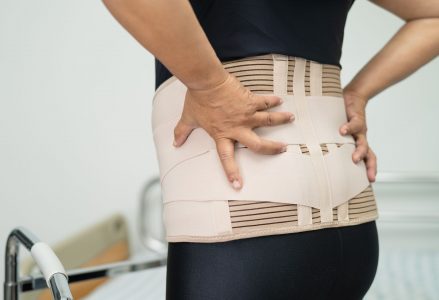Lower back pain is a widespread issue affecting millions of people worldwide. It can be acute or chronic and is often categorized into specific and non-specific types based on its causes.
Symptoms of Lower Back Pain
- Pain: This can range from mild to severe and may be constant or intermittent.
- Stiffness: Reduced flexibility and stiffness in the lower back.
- Limited Mobility: Difficulty moving or performing daily activities.
- Radiating Pain: Pain that travels down the legs, often associated with sciatica.
- Muscle Spasms: Sudden, involuntary contractions of the back muscles.
Causes of Lower Back Pain
- Specific Back Pain:
- Herniated Discs: When a disc bulges and presses on spinal nerves, often causing sciatica
- Fractures: Cracks or breaks in vertebrae, which can occur due to trauma or osteoporosis
- Facet Joint Pain: Pain in the joints linking spinal bones
- Inflammatory Conditions: Such as ankylosing spondylitis, which causes inflammation in spinal joints and ligaments
- Infections or Cancer: Rare but serious causes of lower back pain
- Non-Specific Back Pain:
- Muscle Strains: Overstretching or tearing of muscles, often due to heavy lifting or poor posture
- Poor Posture: Incorrect alignment of the back.
- Lifestyle Factors: Obesity, inactivity, stress, and prolonged standing.
Common Causes
- Sprains & Strains: Injuries to muscles and ligaments
- Traumatic Injury: Falls or car accidents
- Osteoarthritis: Degeneration of spinal joints
- Scoliosis: Abnormal curvature of the back
- Lumbar Spinal Stenosis: Narrowing of the spinal canal
Diagnosis and Testing
Diagnosis typically involves a medical history and physical exam. Imaging tests like X-rays, CT scans, or MRIs may be used to check for bone, disc, or ligament problems
Conclusion
Understanding the causes and symptoms of lower back pain is crucial for effective management. By recognizing these factors and adopting appropriate treatments, individuals can better manage their condition and improve their quality of life
Solutions for Lower Back Pain
Lower back pain can be managed effectively through a combination of lifestyle changes, physical therapies, alternative treatments, and sometimes medical interventions. Here are some comprehensive solutions:
Lifestyle Changes
- Exercise: Regular physical activity, such as walking or swimming, can help strengthen back muscles and improve flexibility
- Physical Therapies
- Physical Therapy: Includes core strengthening, stretching, and aerobic exercises tailored to individual needs14.
- Manual Therapies: Techniques like massage and spinal manipulation can provide short-term pain relief13.
- Aquatic Therapy: Water-based exercises can be beneficial for those with mobility issues
- Treating Lower Back Pain: Symptoms, Causes, and Solutions
When it comes to managing lower back pain, understanding its symptoms and causes is crucial. But what if you could take a proactive step towards relief? Let’s explore how to tackle this common issue and introduce a valuable tool in the fight against lower back pain: the Activa® Back braces . - Activa® Back Braces: A Solution for Lower Back Pain
- Activa® Back braces are designed to provide support and stability to the lumbar back, helping alleviate chronic lower back pain. These braces work by stabilizing the back, reducing motion, and promoting proper posture, which can help manage pain and prevent further strain.
- Key Features of Activa® Back Braces
- Support and Stabilization: Activa® Back braces offer external support to the lower back, helping to stabilize the lumbar back and reduce pain.
- Posture Correction: By encouraging proper posture, these braces can help strengthen back muscles over time.
- Pain Relief: They can reduce pain by limiting excessive motion and providing additional support during daily activities.
- Benefits of Using Activa® Back Braces
- Enhanced Stability: Provides stability to the lower back, which is crucial for managing chronic pain.
- Improved Posture: Helps maintain proper spinal alignment, reducing strain on muscles and joints.
- Pain Management: Can help alleviate pain by limiting motion and providing support.
- Recovery Support: Useful during recovery from injuries or surgeries by providing additional stability
- Conclusion
Activa® Back braces can be a valuable tool in managing lower back pain by providing support, promoting proper posture, and helping to alleviate chronic pain. By combining these braces with other treatments, such as physical therapy and lifestyle changes, individuals can effectively manage their lower back pain and improve their quality of life.


